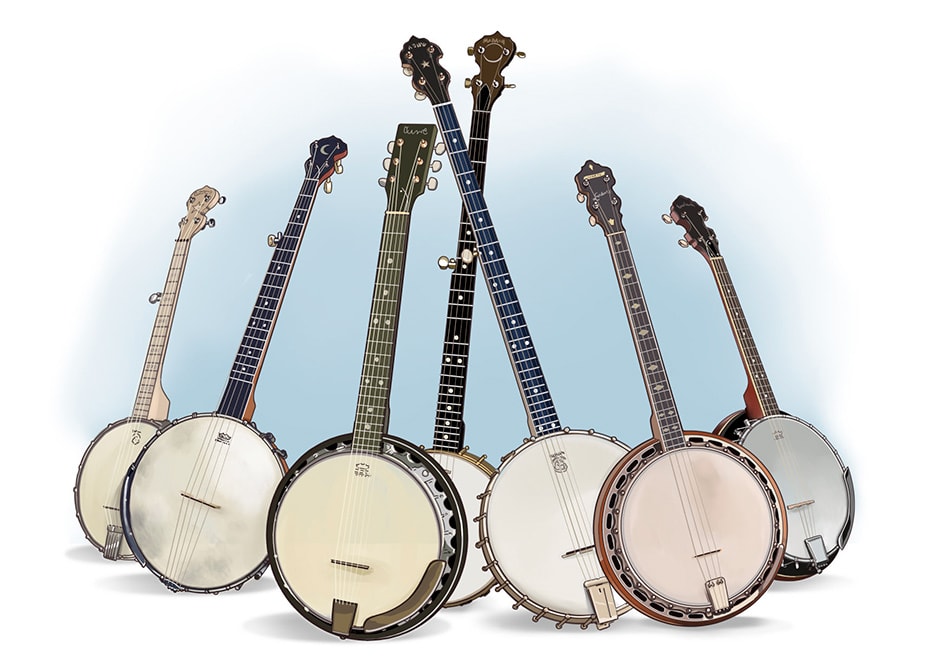One of the most frequently asked questions about banjos is how many strings they have. In this article, we will explore the different types of banjos and answer the question of how many strings a banjo has.

How many Strings does a Banjo have?
The number of strings on a banjo can vary depending on the type of banjo. The most common type of banjo is the 5-string banjo. As the name suggests, this type of banjo has five strings. The strings on a 5-string banjo are typically tuned to an open G chord (g, d, g, b, d.), which gives the banjo its distinctive sound. The fifth string, which is shorter than the other four strings, is often referred to as the drone string. It is typically tuned to a high G note and is used to add depth and complexity to the banjo’s sound. However, there are other types of banjos with different string configurations, such as 4-string and 6-string banjos, each offering unique playing styles and sounds.
The 4-string banjo is sometimes referred to as a tenor banjo, as it is often used in tenor banjo music. The 6-string banjo, also known as a guitar banjo, has six strings and is often played like a guitar. Both the 4-string and 6-string banjos are less common than the 5-string banjo, but they are still used in certain styles of music.
Another type of banjo is the banjo ukulele, also known as a banjolele. As the name suggests, this instrument is a cross between a banjo and a ukulele. It typically has four strings and is often used in jazz and pop music.
There are also specialty banjos, such as the bass banjo, which is used primarily for bass lines in bluegrass music, and the cello banjo, which has a deeper, more mellow tone than a traditional banjo.
In conclusion, the number of strings on a banjo can vary depending on the type of banjo. The most common type of banjo is the 5-string banjo, which has five strings. There are also 4-string and 6-string banjos, as well as specialty banjos such as the banjo ukulele, bass banjo, and cello banjo. Understanding the different types of banjos and the number of strings they have can help you choose the right instrument for your style of music. Whether you’re a beginner or a seasoned player, there is a banjo out there that is perfect for you.
What are the differences between 4-String, 5-String, & 6-String Banjos?
4-String, 5-String, and 6-String banjos are different types of banjos, each with distinct characteristics and purposes. Here are the main differences between them:
- 4-String Banjo: The 4-String banjo is often associated with the tenor banjo and was popularized in early 20th-century jazz and traditional Irish music. It typically has four strings and a shorter neck compared to 5-string banjos. The tuning for a 4-string banjo can vary, but the most common tunings are CGDA (Chicago tuning) and GDAE (Irish tuning).
- 5-String Banjo: The 5-String banjo is the most widely recognized and commonly used type of banjo. It features five strings, four of which are used for playing melodies and chords, while the fifth string is shorter and is played with a thumbpick to create a drone note. The 5-string banjo is associated with various genres, including bluegrass, folk, and old-time music. It is typically tuned to open G tuning (g, d, g, b, d).
- 6-String Banjo (Banjo Guitar): The 6-String banjo, also known as a banjo guitar, is a hybrid instrument that combines the sound and playing style of a banjo with the design and tuning of a guitar. It has six strings and is typically tuned like a standard guitar (EADGBE), allowing guitar players to transfer their skills to the banjo guitar easily. The 6-string banjo offers a different tonal quality compared to traditional banjos and is often used in various musical styles, including country, folk, and contemporary music.
Other Types of Banjo
A 6-string banjo is known by various names such as banjitar, guitjo, ganjo, or banjo guitar. This hybrid instrument combines elements of a banjo and a guitar, featuring six strings tuned like a standard six-string guitar (E, A, D, G, B, E).
An 8-string banjo is referred to as a banjolin or mandolin-banjo. It merges the body of a banjo with the scale length, tuning (G, D, A, E), and neck of a mandolin, making it akin to a type of mandolin rather than a traditional eight-string banjo.
Although Deering offers a 12-string banjo inspired by the 12-string guitar, it remains an uncommon instrument produced in limited quantities and may not be readily available at local music stores. The 12-string banjo is tuned to standard 12-string guitar tuning and can be played using a flat pick or fingerpicks.
